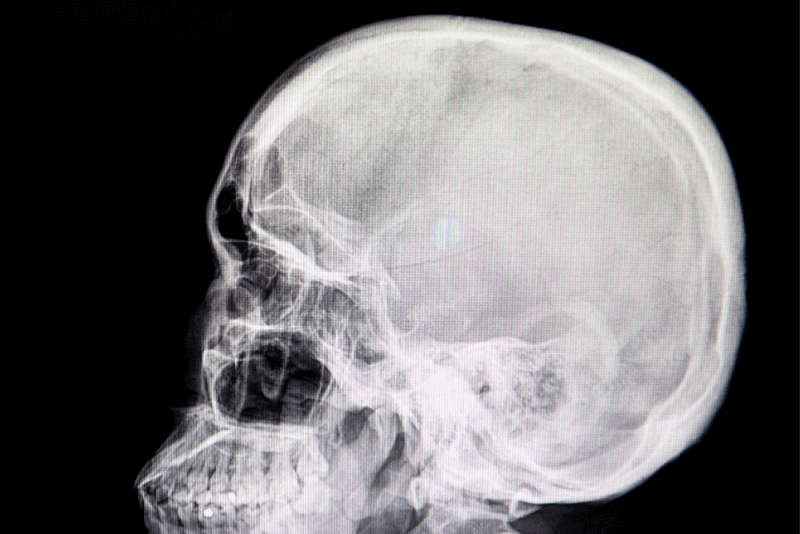What is Trigeminal Neuralgia?
Trigeminal neuralgia is a type of disease that occurs due to the involvement of the trigeminal nerve, which is the fifth cranial nerve that emerges from the brain. It causes very severe pain in the facial area. Patients with Trigeminal Neuralgia experience unbearable pain and burning sensation while performing functions such as eating, talking, shaving, laughing, and applying makeup.
This condition significantly reduces the patient's quality of life. While this disease is very rare in individuals under the age of 30, it is frequently seen in those aged 30 and above. If there is a sudden sensation of pain in any part of the face, it is essential to consult a doctor for diagnosis and treatment without delay.
Causes of Trigeminal Neuralgia
The formation of Trigeminal Neuralgia is associated with factors that result from the disruption of the nervous system. Although this disease is mostly seen in older ages, it can also arise from the following underlying causes.
Aging
As a person ages, nerve tissue begins to lose its vitality and starts to weaken. A nerve cell that has become sufficiently weakened cannot function properly. This problem may lead to the onset of trigeminal neuralgia.
Trauma
Trigeminal neuralgia can develop as a result of trauma caused by external factors or any surgical operation.
Diabetes
One of the most significant side effects of diabetes is the loss of function in nerve tissues due to high blood sugar, which paves the way for the development of trigeminal neuralgia.
Multiple Sclerosis
Multiple sclerosis involves symptoms caused by damage to nerve tissues, which may result in trigeminal neuralgia.
Infections
Nerves can be damaged due to infections such as cold sores experienced during childhood, leading to the development of trigeminal neuralgia.
Symptoms of Trigeminal Neuralgia
Symptoms of trigeminal neuralgia may include one or more of the following:
- Intense shooting or stabbing pain episodes that feel like an electric shock
- Sudden pain attacks triggered by touching the face, chewing gum, or brushing teeth
- Pain attacks that last from a few seconds to a few minutes
- Pain attacks that can occur with facial spasms
- Pain periods that last for days, weeks, or even longer. Some patients experience periods with no pain at all.
- Pain in the area innervated by the trigeminal nerve. This area includes the jaw, teeth, gums, and lips. The eyes and forehead can also be affected more frequently.
- Pain occurring on one side of the face
- Pain that may focus on a single point or spread over a wider area
- Rarely occurs during sleep
- Pain attacks that become more frequent and intense over time
How Long Do Attacks Last?
The duration of trigeminal neuralgia varies from person to person. While some individuals experience this disease mildly or even without any pain, others experience it very severely. The duration of attacks generally observed in individuals with this condition can range from days to weeks, months, or even longer.
Additionally, it has been observed that a constant pain or burning sensation may occur just before the spasmodic pain of trigeminal neuralgia sets in. In general, pain can develop in the areas innervated by the trigeminal nerve, including the cheeks, jaw, teeth, gums, lips, and, less frequently, the eyes and forehead.
These pain symptoms usually occur during mild and routine daily activities involving facial interactions, such as chewing, touching the face, speaking, brushing teeth, and eating. Individuals who experience long-term and recurring facial pain should consult a doctor immediately if the pain does not subside despite using over-the-counter pain relievers.
Diagnosis Methods for Trigeminal Neuralgia
Trigeminal neuralgia is diagnosed based on the description of pain provided by individuals with facial pain and discomfort. The type, location, and trigger mechanism of the pain are very important for making this diagnosis. The pain associated with trigeminal neuralgia is often observed as sudden, shock-like, and short-lived in many cases. The pain linked to trigeminal neuralgia generally occurs when the cheeks are stimulated during activities such as eating, talking, laughing, shouting, touching the cheeks, and even being exposed to a cool and gentle breeze.
Your doctor may use a variety of tests to diagnose trigeminal neuralgia and identify underlying causes. A neurological examination, during which the doctor lightly and moderately touches various parts of the face, helps determine where the pain is located and, if trigeminal neuralgia is diagnosed, which branches of the trigeminal nerve might be affected based on the test results.
Reflex tests performed by the doctor can also help determine whether the symptoms are due to a pinched nerve or some other abnormal condition. This condition can also occur due to multiple sclerosis or the presence of a tumor. To make an accurate diagnosis, the doctor may request a magnetic resonance imaging (MRI) scan of the head.
In some cases, the doctor may also request a magnetic resonance angiography (MRA) by injecting a dye into a blood vessel to visualize the arteries and veins and highlight the pattern of blood flow. Facial pain can stem from many different conditions. Therefore, making the correct diagnosis plays a significant role in applying the appropriate treatment. Additional tests may be necessary, considering the possibility of different conditions.
Treatment Methods for Trigeminal Neuralgia
The treatment of trigeminal neuralgia generally begins with medication. Over time, the symptoms of trigeminal neuralgia may stop responding positively to medications, or unpleasant and serious side effects may occur. For these individuals, different treatment options, including injections or surgical interventions, are available. This disease varies from person to person. While it may leave a mild impression on some individuals, it may cause unbearable impressions on others.
Therefore, in some cases, there may be no need for additional treatment beyond medications.
Medication Treatment for Trigeminal Neuralgia
Medications that reduce or block pain signals sent to the brain are prescribed in the treatment of trigeminal neuralgia. The drug groups used for this purpose include the following:
Anticonvulsant Medications
The effects of anticonvulsant medications may diminish over time. Therefore, dose adjustments may be necessary from time to time. The following are included in the group of anticonvulsant medications:
- Carbamazepine
- Oxcarbazepine
- Lamotrigine
- Phenytoin
- Topiramate
- Pregabalin
- Gabapentin
Side effects of these anticonvulsant medications include dizziness, confusion, nausea, and drowsiness. Additionally, carbamazepine may cause serious reactions in patients of Asian descent. Therefore, genetic testing should be performed on Asian patients before starting this group of medications.
Muscle Relaxants
Muscle relaxants such as Baclofen may be prescribed alone or in combination with carbamazepine. The side effects of muscle relaxants include confusion, nausea, and drowsiness.
Botox Injections
A small study on Botox injections has shown that it is effective in patients who do not benefit from medications. However, larger-scale studies are needed before this application can be widely used.
Surgical Methods for Trigeminal Neuralgia
The surgical methods that may be chosen for trigeminal neuralgia include the following:
Microvascular Decompression
In this procedure, the blood vessels touching the trigeminal nerve are moved or removed to address nerve-related problems. An incision is made behind the ear during the procedure. Then, from this small incision, the artery touching the nerve is moved. In some cases, a cushion is placed between the nerve and the blood vessel.
If the artery is compressing the nerve, part of the artery needs to be removed. If the artery is not compressing the nerve, part of the trigeminal nerve may need to be removed. This operation is called neurectomy.
Neurectomy may result in pain relief or reduction for many years. However, the type of pain and the patient's age are important factors. It is rare for patients to experience pain within 3-5 years after the blood vessel compressing the nerve is removed.
Complications that may arise from microvascular decompression operations include hearing loss, facial weakness, numbness, and paralysis.
Stereotactic Radiosurgery (Gamma Knife)
In this procedure, radiation is delivered to the trigeminal nerve root. The radiation damages the nerve, causing the pain to gradually decrease. It may take up to a month for the pain to completely disappear.
This procedure is effective in many patients, but pain may return within 3-5 years. If the pain returns, the procedure can be repeated, or another treatment option may be chosen.
The side effect of the treatment is facial numbness. Numbness may occur immediately after the procedure or develop over the years.
Rhizotomy
This procedure involves destroying nerve fibers to reduce pain. Therefore, it may cause some numbness. Rhizotomy includes various procedures within itself.
Glycerol Injection
In this procedure, medication is injected into the cerebrospinal fluid sac surrounding the area where the trigeminal nerve branches into three. The injected medication damages the nerve and blocks pain signals. Pain often returns in many patients after the procedure. Additionally, numbness and tingling may be observed in the face after the procedure.
Balloon Compression
In this procedure, a needle is directed to a part of the trigeminal nerve located at the base of the skull. Then, a catheter with a balloon at its end is passed through the needle. The balloon is then inflated enough to compress the nerve.
Balloon compression temporarily relieves the pain of patients. Although the procedure has a high success rate, patients may temporarily experience facial numbness after the procedure.
Radiofrequency Thermal Lesioning
This procedure, performed under sedation, involves selecting and damaging the nerve fibers that cause pain. After placing a needle in the nerve, the patient is awakened, and electrodes are placed in the needle to apply electrical currents to the nerves. The patient informs the doctor when they feel tingling.
Once the nerve causing the pain is identified, the patient is put back to sleep. The identified nerve is then lesioned using heated electrodes. If the lesion effectively relieves pain, additional lesions may be created. Patients are expected to experience some numbness in their faces after the procedure. It is possible for the pain to return 3-4 years after the procedure.
Benefits of Trigeminal Neuralgia Surgery
One of the primary advantages of trigeminal neuralgia surgeries is the immediate relief from pain in most methods. It is not common for the pain to return after the operations. As a result, permanent improvement is seen in a significant number of patients.
If the pain recurs, the procedure can be repeated. Therefore, surgery can eliminate chronic pain.
Complications of Trigeminal Neuralgia Surgery
Various procedures are applied in trigeminal neuralgia surgeries. Therefore, the complications that may arise vary. The most severe complications are seen in MDV operations because a small hole must be drilled into the skull. Serious complications include infection, excessive bleeding, cerebrospinal fluid leakage, and general anesthesia risks.
Post-Surgery Process for Trigeminal Neuralgia
The most serious procedure in treating trigeminal neuralgia is microvascular decompression surgery. Therefore, the points that need to be considered after the procedure are much more extensive.
After MDV operations, patients need to use antibiotics for 2-4 weeks to prevent infection. The medications will be gradually discontinued after a month.The stitches in the incision area are removed approximately 10 days after the procedure. Patients need a one-month recovery period before returning to work and daily life.
Risks of Trigeminal Neuralgia
The risk factors that can trigger and cause trigeminal neuralgia include the following:
- Shaving
- Touching the face
- Eating
- Brushing teeth
- Talking
- Applying makeup
- Exposure to wind
- Smiling
- Washing the face
Some individuals are at higher risk for trigeminal neuralgia compared to others. The risk factors include:
- Women are at higher risk compared to men.
- More common in individuals aged 50 and over.
- Having hypertension
- Having multiple sclerosis
What Should Trigeminal Neuralgia Patients Pay Attention To?
Patients experiencing trigeminal neuralgia pain should pay attention to certain points to alleviate the pain attacks or reduce their frequency.
- Triggers should be avoided. Common triggers include hot and cold drinks, spicy foods, and wind exposure.
- Using a straw can help prevent the effects of hot and cold foods and drinks.
- During pain, hot or cold compresses can be applied. Some individuals may find that a cold compress helps relieve the pain. However, if a person has cold sensitivity, it may have the opposite effect. In such cases, a hot compress is recommended.
What Is It Like Living with Trigeminal Neuralgia? How to Cope During Treatment?
Living with trigeminal neuralgia can be very challenging for individuals. Spending a day in pain and burning sensation is difficult for everyone. This disorder significantly affects the quality of daily life. They cannot perform daily activities like other people and endure a great deal of pain and suffering.
This situation can be easier to cope with by seeking help from a support group. Members of support groups are usually well-informed about trigeminal neuralgia symptoms, the latest treatment methods, the progression of the disease, etc., and tend to share their experiences within the group.
Patients diagnosed with trigeminal neuralgia are often referred to support groups by their doctors during treatment. Through the support and information shared by different individuals, the challenging process can be easier to get through.







